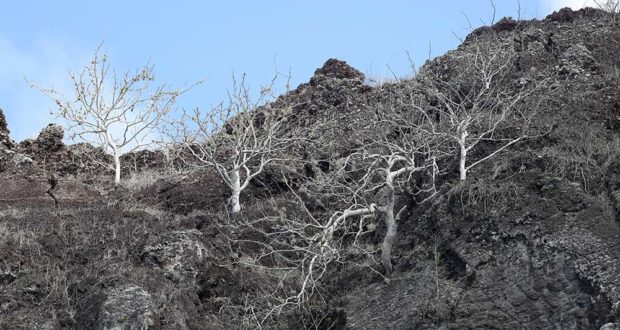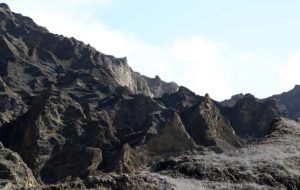Nothing could be less inviting than the first appearance. A broken field of black, basaltic lava, thrown into the most rugged waves, and crossed by great fissures, is every where covered by a stunted, sun-burnt brushwood, which shows little signs of life. The dry and parched surface, being heated by the noonday sun, gave to the air a close and sultry feeling, like that from a stove: we fancied even that the bushes smelt unpleasantly.
Charles Darwin, 15 September 1835
The Galapagos Islands certainly made a poor impression on most of their early visitors.
In addition to Darwin’s dreary imagery, Herman Melville described the islands as,
… rock-bound, or, more properly, clinker-bound; tumbled masses of blackish or greenish stuff like the dross of an iron-furnace, forming dark clefts and caves here and there, into which a ceaseless sea pours a fury of foam; overhanging them with a swirl of gray, haggard mist, amidst which sail screaming flights of unearthly birds heightening the dismal din … In no world but a fallen one could such lands exist.
A group of Norwegian settlers, drawn to the Galapagos in the 1920s by a misleading newspaper advertisement were shocked when they arrived on San Cristobal:
There it was, so very different from the tropical island we had imagined—no tall trees—no green grass—only bare, grey lava boulders along the entire shoreline, and higher up an intertwined jungle of thorny, ugly bushes. Disappointment was plain on all faces.
Admittedly, the islands are not a tropical paradise, but their charms lie elsewhere, as Darwin soon came to realize.
My first impression came from the air as we approached the northern end of San Cristobal. A life-size topographical map unfolded below the clouds, with the terrain marked in appropriate colors. A thin edge of black surrounded most of the island, broken up intermittently by narrow white sand beaches. Just inland the hue changed to a dusky brown and then, toward the island’s center, a verdant green. The barren northern end of the island was pocked by small craters.
A day later, I visited the place where Darwin supposedly first came ashore – near Cerro Tijeretas toward the south end of the island – and at least part of his description was apt.
Black, jagged lava rock confronted the sea along most of the shoreline, dripping here and there with stark white bird droppings. Thereafter, the landscape became a tangled orchard of leafless, silvery gray trees with arthritic branches. They were Palo Santo (Bursera graveolens), known locally as Incense Trees. The locales told me that the trees become a lush green during the wet season. Darwin and I just arrived at the wrong time.
A gray rock cliff rose steeply from a small cove nearby, a handful of intrepid Palo Santo clinging to its face. Above, frigatebirds soared in long, lazy circles, forming sharp, angular silhouettes against the sky. The water in the cove shimmered an emerald green. At the top of a nearby hill, a statue of Darwin faced landward, looking grim.
When pondering Darwin’s initial description of the island, I have to remember that everything is relative. When he, Melville and the Norwegians arrived, they were coming to what they might have expected to be a lush tropical island, sitting only a degree south of the equator. What they saw was rough black lava rock tumbling down to the sea, backed by lifeless trees, perhaps on a gray, cloudy day. I saw the same thing, but the sun rendered the sea in deep blues and greens, and I approached the landscape with the knowledge of what lay within and beyond the Palo Santo.


